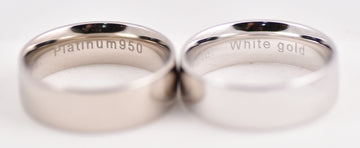When it comes to selecting the ideal metal for your jewelry, particularly for engagement rings and wedding bands, two popular options often come into consideration: platinum and white gold. Both metals have their unique qualities and allure, making the decision a challenging one. To make an informed choice, it's essential to understand the characteristics, durability, and aesthetics of each metal.
Platinum: Timeless Elegance and Durability
Platinum is a naturally white metal, known for its timeless elegance and durability. Its naturally white luster does not fade or tarnish over time, ensuring that your jewelry will maintain its beauty for generations. This remarkable resistance to wear and tear makes platinum the top choice for engagement rings, where durability and longevity are paramount.
One of the outstanding features of platinum is its purity. Unlike white gold, which is an alloy of gold and other metals, platinum jewelry is usually 95% pure. This high level of purity makes platinum hypoallergenic, making it an excellent choice for individuals with sensitive skin.
Furthermore, platinum is significantly denser than gold, giving it a substantial feel that many find appealing. It is also more resistant to scratches and dings, making it an ideal choice for those with an active lifestyle. Over time, platinum develops a natural patina, enhancing its character and adding a unique charm to the jewelry.

White Gold: Versatility and Affordability
White gold, on the other hand, is an alloy of gold mixed with other white metals, such as palladium, nickel, or silver. It is then coated with a thin layer of rhodium, a precious metal that enhances its white color and provides a protective layer against tarnishing. This plating, however, can wear off over time, requiring periodic re-plating to maintain its original luster.
One of the significant advantages of white gold is its versatility. It can be crafted into intricate designs and is relatively more malleable than platinum, allowing jewelers to create detailed and ornate pieces. Additionally, white gold offers a more budget-friendly option for those seeking the elegant look of platinum without the higher price tag.
However, it's crucial to consider that some individuals may have allergic reactions to the nickel content in white gold alloys. To address this issue, many jewelers now use nickel-free alloys, making white gold a safer choice for people with sensitive skin.
Making the Decision: Personal Preference and Lifestyle
Ultimately, the choice between platinum and white gold comes down to personal preference, lifestyle, and budget. If you prioritize durability, purity, and a substantial feel, platinum is the ideal choice. Its natural white luster and hypoallergenic properties make it an excellent investment for a lifetime of wear.
On the other hand, if you prefer versatility, intricate designs, and a more affordable option, white gold might be the right choice for you. Just keep in mind the need for occasional maintenance due to the rhodium plating wearing off over time.
Before making a decision, it's advisable to consult with a reputable jeweler who can guide you based on your preferences and requirements. Additionally, consider trying on different pieces made from both metals to see which one resonates with you the most.
In the end, whether you choose the enduring elegance of platinum or the versatility of white gold, both metals can create stunning and cherished pieces of jewelry that reflect your style and stand the test of time.

















